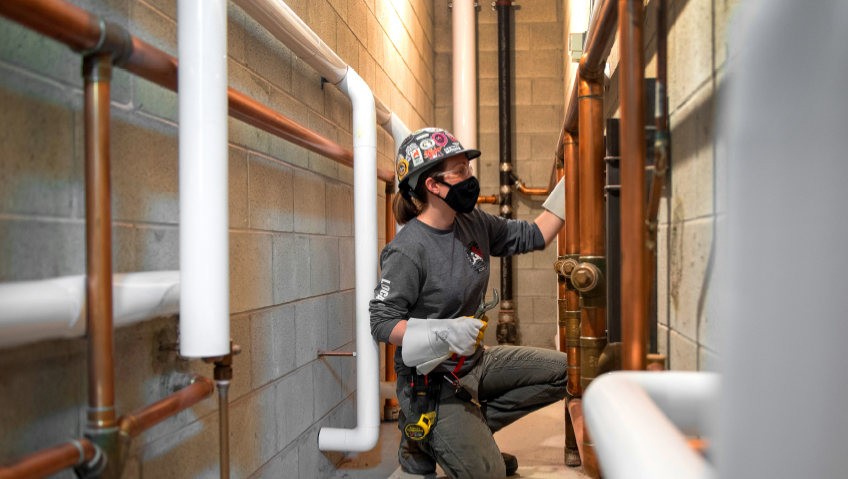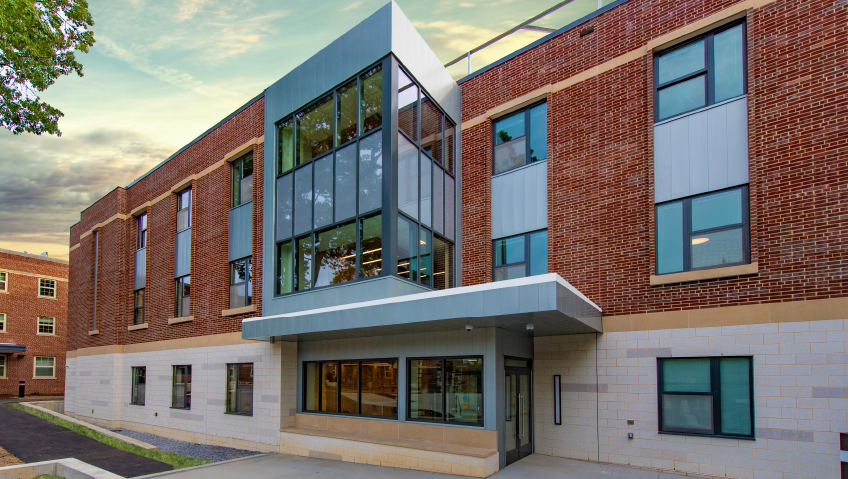Rachel Hesketh didn’t set out to be a plumber. In her mid-20s, while on a completely different career path, she felt she needed a change. Looking for something where she could work with her hands, she discovered a pre-apprenticeship program aimed at getting women into the trades. The rest is history that’s still being written.
“The program was offered through the United Association (UA) Local 67 Technical Trade academy – my local union that represents plumbers, steamfitters, welders and supporting apprentices,” says Hesketh, now 29. “The six-month program allowed me to study theory and the practical application of a few different trades — welding, plumbing, steamfitting — and then choose one to do a work placement in.”
At the end of the pre-apprenticeship program, Hesketh enrolled in a five-year apprenticeship program with the UA, a mix of paid working hours and in-school training. Hesketh completed three eight-week sessions in school and 9,000 hours of work during those five years. She was also fortunate enough to have access to “amazing” safety and skills training through her union, which helped her gain self-confidence on job sites and gave her a leg up in school.
Taking that chance on a completely new, unfamiliar journey led Hesketh to where she is today.
“My biggest accomplishment has been my ability to step outside my comfort zone into an unknown path,” she says. “It’s allowed me to find something I’m passionate about and I’ve loved the journey to becoming a journeyperson plumber.”
According to BuildForce Canada, more than 257,000 construction workers will retire by 2029, leaving a shortfall of nearly 82,000 workers. Who better to fill those potentially lifelong, lucrative career opportunities than the younger generation who may have never entertained the possibility of working in the trades?
Dale McGavin, Director of Training at UA Local 67, was one of Hesketh’s first teachers when she started trade school. He remembers her well, including her initial hesitancy about learning new skills.
“Rachel is one of the success stories,” he says. “I first met her when I was teaching a welding pre-apprenticeship program. If I remember correctly, she had never even struck an arc. She was very scared to be in the booth, but by the end of it she was welding away. That sticks out because we were talking about it afterwards and joking around, because she said she couldn’t believe how scared she was. She did really well.”
McGavin now looks after the apprentices, schedules their training, and ensures they finish their apprenticeships on time. He also encourages certain students to get involved in various outreach programs to help bring new students on board. Outreach programs include educating students both before and during high school in order to expose young people to what the trades are all about.
“We bring different tools of the trade and get them to do some soldering, connections with plastic pipe, [use] cameras to look inside fibre optics, so they become aware of the trades as a career path,” says McGavin. “We like to get apprentices actively involved, because they’re fairly young and they’re an example.”
Hesketh just successfully completed her CFT, meaning she’s a registered plumber. Her pathway started from pre-apprenticeship and she’s been actively engaged all the way, making her a “huge deal and a great success story.”
“I love knowing that as a journeyperson plumber, I’m helping bring important projects in my city to life,” says Hesketh. “Beyond that, the skills and safety training, mentorship, volunteer opportunities and sense of camaraderie that come with being a unionized tradesperson are very rewarding. As the leader of the Evolve Committee, a youth committee through my union that aims to encourage mentorship between journeypersons and apprentices, it’s the type of work I’d like to continue doing in the upcoming years.”
It’s exactly that kind of exposure, hands-on learning and education that’s needed in the grade school and high school environments to show students various available career paths. But a lingering stigma regarding academic abilities versus working with your hands creates a huge misconception about the trades in general, says McGavin.
“High schools and guidance counsellors are still pushing for universities and colleges, and we need to show them this is a great way to earn a living,” he says. While he took tech all through school because he “loved doing it,” he knows there’s a lack of knowledge surrounding the trades as a career.
“The idea that if you can’t do academic there are always trades as a fallback is so wrong,” he says. “It’s not that way at all. The pre-requisite for UA67, specifically for apprenticeship, is a minimum of Grade 12. Education is important. There’s a misconception that if you do trades you’re not doing college or university, even though trade school is post-secondary.”
People also don’t realize there’s a theory aspect as well as a practical one. While you obviously have to physically perform, there are also eight weeks of schooling, three levels over the course of five years. When you pass, you have to prove the reason why you do things a certain way, he says, and the topics discussed in class can seem right out of left field. Some of the science classes in the trades would make academics feel lost.
“But you get paid to learn the whole way through. You don’t come out with student debt. It’s a huge deal. You get a respectable wage depending on level, usually 40 percent of overall rate for level one, and it goes up from there.”
McGavin represents 300 apprentices, and performs the hiring and intake process. He says many students are a bit older and have already gone the post-secondary academic route. They chose to later enter the trades, where there’s an opportunity for a stable career and a good wage.
“Most people don’t know about trades before high school,” says McGavin, who is also a high school teacher. “It’s the first time in their life they’re faced with a choice and thinking about what they want to do at the end of five years. By Grade 10, a guidance counsellor will push people to the thing they think they’re supposed to be in, based on what they know about the student. You need to educate them and let them know it’s a career path early on.”
Hesketh strongly agrees. “For me, the biggest reward is the lifelong learning you get access to as a tradesperson. Also, while an apprenticeship may seem like a lot of time and commitment, it goes by really quickly and you earn while you learn!”
Hesketh also stresses the many opportunities to learn and grow while working. “It really is more than just a job. If you get involved in your local trade union, you have access to volunteering, social networking, mentorship and amazing opportunities to learn,” she says. “As I just finished my apprenticeship, I’m quite happy with the direction I’m going in at this time. I still have a lot to learn and practical knowledge to acquire, so my focus is to take the time to learn and grow as a journeyperson. That said, I’d like to take on more of a role in mentorship and eventually work toward teaching one day.”
When asked about sexism in the industry, and whether that culture has changed, McGavin doesn’t hesitate to say that it has.
“When I did my apprenticeship, we would notice there’s a girl in the class. That’s what the conversation was about because it was the beginning of that culture change,” he says. “Back in the old days trades were for men. It was a pride thing.”
When he was still teaching, of the 12 students at each level, two or three were women all the way through consistently, and he sees that continuing.
Hesketh agrees. “I want women interested in a career in the trades to know that we’re seeing a positive cultural shift in the industry,” she says. “It’s definitely very progressive for women in the workforce. With the UA, for example, people get paid based on their qualifications, not their gender or background. On top of that, in 2019 the United Association established a parental wellness program to support women and new parents through EI top ups and more. Also, if a pregnant woman is healthy enough to work but unable to perform regular duties, the employer will either offer them lighter duties or they’ll receive an equivalent to EI from the UA to stay home and keep themselves and their unborn child safe.”
That sentiment is echoed across the board nationwide, says McGavin: People are retiring and being replaced by “everyone.”
“They’re being replaced by men, women, [people of] different races, different cultures: it makes no difference, nobody cares in the trades. The only thing people about is that you’re safe and can you do the job.”
McGavin’s job now involves strategic planning to encourage a diverse workforce comprising people from all walks of life: there are a lot of different people out there, he says.
“Rachel is a no-brainer when we’re talking about this, because it makes sense to have a woman who shows they’re excited and has pride in what they do,” says McGavin. “She shares that with younger women who are thinking about careers. Now you’ve got a model for success. Rachel recently got third in a skills competition — the third best plumber apprentice in Ontario. Kind of a big deal!”
On top of a variety of mental skills, McGavin stresses that to be a successful worker today, you not only need the education, you need to be trainable, and above all, you need to be safe.
“People are scared of the trades. People really do think they’re going to get hurt because they’re working with tools. Some of the stuff we do is scary and dangerous. That’s where proper training comes in.”
UA67 is 31 percent safer because of its mandated extra training, says McGavin. Additional training involves taking a course every year in the evening for five years that may include advanced blueprint reading, new joining methods, or CAD. Training equals safety, he says, and that means people are safer in the field.
“I would tell women thinking about a career in the trades to take advantage of what their trade union offers, especially the safety and skills training,” adds Hesketh. “I’m really grateful for the high standard my union puts on safety. It makes me feel safe, confident and comfortable on job sites.”
Through education, outreach programs and involving passionate people like Rachel Hesketh, the entire culture surrounding trades and those who are “good fits” is changing, too. Parents benefit from understanding the requirements for their children, and from the realization that workers are paid to learn and come out with a good job and no student debt.
“After an outreach program, it’s amazing how I get calls from parents three months later saying, ‘my kid is interested, how do we do this?’” says McGavin. “The more information that everyone has, the better for all the trades.”
For Hesketh, she’s well on her way to a satisfying, lifelong career that she forged through passion and dedication.
“I recently completed my apprenticeship and feel there is still so much to learn,” she says. “However, I’m very grateful for the support from my partner, friends and colleagues who keep me grounded and remind me of the hard work I’ve put in to get to where I am today.”






